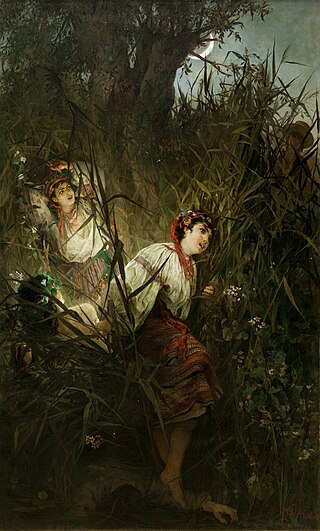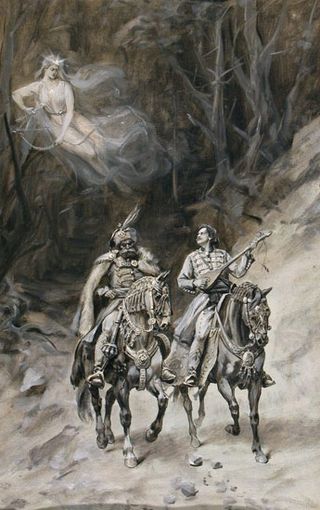Related Research Articles
In Latvian mythology, the term Māte stands for "mother", sometimes written in English as Mahte. It was an epithet applied to some sixty-seventy goddesses. They were clearly distinct goddesses in most or all cases, so the term definitely referred to the mother-goddess of specific phenomena. According to professor Lotte Motz, scholar Haralds Biezais mentioned there were at least 70 characters in Baltic religion identified with the title of Mate.

In Slavic mythology, vodyanoy is a water spirit. In Czech and Slovak fairy tales, he is called vodník, and often referred to as Wassermann in German sources. In Ukrainian fairy tales, he is called “водяник“ (vodyanyk).

Mokosh is a Slavic goddess. According to etymological reconstruction, Mokosh was the goddess of earth, waters and fertility, and later, according to most researchers, she was reflected in bylinas and zagovory as Mat Zemlya. Another reconstruction was made on the basis of ethnography: at the end of the 19th century, such names of kikimora as Mokusha or Mokosha were recorded in the Russian North. The coincidence is explained by the fact that kikimora is a demonized version of the goddess, and by approximating between the two, researchers have portrayed Mokosh as the goddess of love and birth, with a connection to the night, the moon, spinning, sheep farming and women's economy. Spinning was the occupation of various European goddesses of fate, which led to the characterization of Mokosh as a deity controlling fate. This reconstruction does not agree with the data on her etymology, which shows that the function of spinning could not have been the main one.

Other than the many gods and goddesses of the Slavs, the ancient Slavs believed in and revered many supernatural beings that existed in nature. These supernatural beings in Slavic religion come in various forms, and the same name of any single being can be spelled or transliterated differently according to language and transliteration system.

The Tale of Tsar Saltan, of His Son the Renowned and Mighty Bogatyr Prince Gvidon Saltanovich and of the Beautiful Swan-Princess is an 1831 fairy tale in verse by Alexander Pushkin.

Anastasia Romanovna Zakharyina-Yurieva was the tsaritsa of all Russia as the first wife of Ivan IV, the tsar of all Russia. She was also the mother of Feodor I, the last lineal Rurikid tsar of Russia, and the great-aunt of Michael of Russia, the first tsar of the Romanov dynasty.
Iriy, Vyrai, Vyriy, or Irij is a mythical place in Slavic mythology where "birds fly for the winter and souls go after death" that is sometimes identified with paradise. Spring is believed to have arrived on Earth from Vyrai.

A bogatyr or vityaz is a stock character in medieval East Slavic legends, akin to a Western European knight-errant. Bogatyrs appear mainly in Rus' epic poems—bylinas. Historically, they came into existence during the reign of Vladimir the Great as part of his elite warriors (druzhina), akin to Knights of the Round Table. Tradition describes bogatyrs as warriors of immense strength, courage and bravery, rarely using magic while fighting enemies in order to maintain the "loosely based on historical fact" aspect of bylinas. They are characterized as having resounding voices, with patriotic and religious pursuits, defending Rus' from foreign enemies and their religion.

Sirin is a mythological creature of Russian legends, with the head of a beautiful woman and the body of a bird, borrowed from the siren of the Greek mythology. According to myth, the Sirin lived in Iriy or around the Euphrates River.

A vila, or víla is a Slavic fairy similar to a nymph.

In Slavic folklore, the rusalka is a female entity, often malicious toward mankind and frequently associated with water, it has counterparts in other parts of Europe, such as the French Melusine and the Germanic Nixie. Folklorists have proposed a variety of origins for the entity, including that they may originally stem from Slavic paganism, where they may have been seen as benevolent spirits. Rusalki appear in a variety of media in modern popular culture, particularly in Slavic language-speaking countries, where they frequently resemble the concept of the mermaid.
A water spirit is a kind of supernatural being found in the folklore of many cultures:

Kostroma is an East Slavic fertility goddess. Her name is derived from костёр (kostyor), the Russian word for "bonfire".
Poludnitsa is a mythical character common to the various Slavic countries of Eastern Europe. She is referred to as Południca in Polish, Полудниця in Ukrainian, Полудница (Poludnitsa) in Serbian, Bulgarian and Russian, Polednice in Czech, Poludnica in Slovak, Připołdnica in Upper Sorbian, and Полознича (Poloznicha) in Komi, Chirtel Ma in Yiddish. The plural form of this word is poludnitsy. Poludnitsa is a noon demon in Slavic mythology. She can be referred to in English as "Lady Midday", "Noonwraith" or "Noon Witch". She was usually pictured as a young woman dressed in white that roamed field bounds. She assailed folk working at noon, causing heatstrokes and aches in the neck; sometimes she even caused madness.

Slavic fantasy is a sub-genre of contemporary art that developed in the late 90s and early 2000s. Slavic fantasy is distinguished by the incorporation of Slavic folklore, legends, bylinas, and myths into the general canons of fantasy literature. However, its genre boundaries remain indistinct.
The Maiden Tsar is a character in East Slavic folktales. It is best known from Alexander Afanasyev's eight-volume collection Narodnye russkie skazki (1855—1863), folktale "Царь-девица"; variants recorded in Orenburg Governorate and Perm Governorate.

The Mistress of the Copper Mountain, also known as The Malachite Maid, is a legendary being from Slavic mythology and a Russian fairy tale character, the mountain spirit from the legends of the Ural miners and the Mistress of the Ural Mountains of Russia. In the national folktales and legends, she is depicted as an extremely beautiful green-eyed young woman in a malachite gown or as a lizard with a crown. She has been viewed as the patroness of miners, the protector and owner of hidden underground riches, the one who can either permit or prevent the mining of stones and metals in certain places.

The Alatyr in East Slavic legends and folklore is a sacred stone, the "father to all stones", the navel of the earth, containing sacred letters and endowed with healing properties. Although the name Alatyr appears only in East Slavic sources, the awareness of the existence of such a stone exists in various parts of the Slavdom. It is often mentioned in stories and referred to in love spells as "a mighty force that has no end."

The Sea Tsar and Vasilisa the Wise is a Russian fairy tale published by author Alexander Afanasyev in his collection of Russian Fairy Tales, numbered 219. The tale features legendary characters Sea Tsar and Vasilisa the Wise.

Unclean force is a collective name in Slavic paganism for mythological forces and creatures including evil spirits, chorts, demons, werewolves and the undead — Domovoy, Polevik, Vodyanoy, Leshy, rusalka, kikimora and other. Common to all of them is belonging to the "unclean", "negative", "out of this world", the otherworldly world and their malevolence towards people. Shepherds, millers, blacksmiths, witches and sorcerers were suspected of having ties with evil forces.
References
- 1 2 Remizov, Aleksey (2004). Сторона небывалая: легенды, сказки, сны, фантастика, исторические были-небыли [An unprecedented side: legends, fairy tales, dreams, fantasy, historical true and fiction] (in Russian). Russkiy Put'. p. 479. ISBN 9785858871552.
- 1 2 Prokhorov, Vasily (1872). Русския древности: с рисунками, относящимся ко вшем отрослям русского искусства, разъясняющими события историческия и быт народный во всех отношениях: в военном, гражданском, домашнем и русской одежды в разных периодах и пр [Russian antiquities: with drawings related to all branches of Russian art, explaining the events of the historical and folk life in all respects: in the military, civilian, domestic, and Russian clothes in different periods, etc.] (in Russian).
- 1 2 Kononenko, Aleksey (1993). Персонажи славянской мифологии: рисованый словарь [Characters of Slavic Mythology: A Drawn Dictionary] (in Russian). Kharkov: Korsar. ISBN 9785770722307.
- 1 2 3 4 Vagurina, Lyudmila (1998). Славянская мифология [Slavic mythology] (in Russian). Linor & Sovershenstvo. ISBN 9785808900240.
- 1 2 Elena Kryuchkova, Olga Kryuchkova (2019). Illustrated Encyclopedia of Ancient Slavic Gods and Spirits. Babelcube Inc. ISBN 9781547577798.
- 1 2 Kononenko, Aleksey (2013). Энциклопедия славянской культуры, письменности и мифологии [Encyclopedia of Slavic culture, writing and mythology] (in Russian). Folio. ISBN 9785699748600.
- ↑ Afansyev, Alexander (1994). Поэтические воззрения славян на природу [The Poetic Outlook of Slavs about Nature] (in Russian). Indrik. ISBN 5-85759-009-4. Archived from the original on 2015-04-16. Retrieved 2021-12-11.
- 1 2 "Разновидности русалок" [Kinds of rusalki]. Моя библиотека (in Russian).
- ↑ "Легенды и предания. Водяница" [Legends and Stories. Vodyanitsa]. Русская история (in Russian).
- ↑ Shubin, Daniel (2004). A History of Russian Christianity, Vol. I: From the Earliest Years through Tsar Ivan IV. Algora Publishing. p. 73. ISBN 9780875862873.
- ↑ "Моряна. Словарь ветров" [Moryana. Dictionary of the Winds].